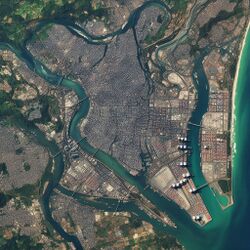Vilauristre: Difference between revisions
mNo edit summary Tag: 2017 source edit |
mNo edit summary Tags: Mobile edit Mobile web edit Advanced mobile edit |
||
| Line 173: | Line 173: | ||
==== Audonian Cuisine ==== | ==== Audonian Cuisine ==== | ||
==== Fusion Food ==== | ==== Fusion Food ==== | ||
Revision as of 20:24, 12 February 2024
Script error: The module returned a nil value. It is supposed to return an export table.
Vilauristre | |
|---|---|
Capital City of the Nation of Burgundie and the Principality of the Ile Burgundie | |
 The view of Vilauristre from space | |
| Nation | |
| Constituent Country | |
| Population | |
| • Total | 8,500,000 |
Vilauristre is the capital city of the Nation of Burgundie and the Principality of the Ile Burgundie. It has a population of 8.5 million people and has been an important trading hub since its settlement in the 4th or 5th century BC. The city has served as the political and administrative capital of Burgundie since 1462. Urban renewal is pervasive and greenovation has taken the development of the city by storm. While green space is fairly accessible to most residents the high density of the city means that most buildings are multi-family, mid or high-rise, with single-family homes only accounting for 2.1% of the total residential market. Public transit is the primary mode of inner city transport in Vilauristre. It is called ViaVille and consists of a network of light rail, buses, and ferries. Since 2019 all public transit in the city is automated. Safety officers are present on higher risk routes but have yet to encounter any incidents of accidental death. Vilauristre has 9 boroughs: Harborside, The Quays, Commerce Street, Devil's Den, AMA, Riulinha, Aldelmar Park, South Vilauristre, and Casernecamp. It also hosts several festivals throughout the year, including the Vilauristre Fringe Festival, Summer in the City Festival, Vilauristre Art and Film Lay Synod, Dockfest, Rue de Oulechard Jazz Festival, and Céilí and Sail Éille.
History
Historical affiliations:
- Kingdom of the Impari Impaxi 350 BC–132 AD
- The Bergenddium 132–636
- Alvaria 636–937
- Archbishopric of Rabascall-Bergendia 937–1175
- Vilauristre Conference 1175–1597
- Kingdom of Magnia-Bourgondi 1597–1725
- Duchy of Bourgondi 1725–1793
- Duchy of Bourgondi-Estia 1793–1812
- Burgundie 1812–present
First settled in the 4th or 5th century BC by Impari Impaxi peoples, the city was formally incorporated in 1247 and then elevated to city status in 1478. It has served as an important trading hub in southeastern Levantine circuit since its settlement and has been the capital of 4 civilizations or nations. Following its modernization in the late-1800s, it was one of the few metropolitan areas with a population already over one million residents. After the Second Great War, the population boomed again and has been growing steadily ever since.
Vilauristre has served as the political and administrative capital of the Burgundie since 1462, more or less. There were a few instances where the government evacuated the city to avoid riots, mobs or military incursion, but for the most part, the legacy of government has always rested in the city. During the period of the Trade Company Empires, Vilauristre was catapulted into the world of global politics. It became only regionally important following the independence of Burgundie at the cost of its overseas empire in Audonia, Alshar, and Vallos. Wallowing in relative obscurity for the next century Vilauristre played second fiddle to Port Diteaux, which took on a global role during the Trade Route Empire. As the 20th century dawned and the country embarked on the era known locally as the Pax Burgundia, Vilauristre clawed its way back into the spotlight. Particularly in the aftermath of the Second Great War, Vilauristre, emerging entirely unscathed, steadily grew its influence as a global intermediary and negotiation center.
Today the city is vibrant and diverse with a massive population. Urban renewal is pervasive and greenovation has taken the development of the city by storm. While green space is fairly accessible to most residents the high density of the city means that most buildings are multi-family, mid or high-rise, with single-family homes only accounting for 2.1% of the total residential market. Also due to the population density, most mid- and high-rise buildings are multi-use. The first one or two stories being commercial with a residential tower above is a common layout in the city. Problems with drug abuse, homelessness, and poverty are prevalent in some of the lower-class neighborhoods, but a very strong and well funded Department of Public Health and Social Resiliency keep the numbers of residents suffering those indignities at proportionally low rates.
Vilauristre Defensive Positions
The Vilauristre Defensive Positions were a late 19th century scheme of earthwork fortifications in the south-east of Burgundie, designed to protect Vilauristre from foreign invasion landing on the south coast. The positions were a carefully surveyed contingency plan for a line of entrenchments, which could be quickly excavated in a time of emergency. The line to be followed by these entrenchments was supported by thirteen permanent small polygonal forts or redoubts called Vilauristre Mobilization Centers, which were equipped with all the stores and ammunition that would be needed by the troops tasked with digging and manning the positions.
An 1847 report on Burgundie's defenses believed that Vilauristre was practically undefendable. Following a number of proposals by senior military figures, an 1867 memorandum envisaged a scheme of simple earthworks for infantry and movable armaments, intended to be dug and manned in an emergency by the militia, the line being supported by permanent works, the Vilauristre Mobilization Centers, at 8km intervals, which acted as stores and magazines.
The Vilauristre Mobilization Centers were built along a 113-kilometer stretch of the Biscaine Bay's coastline. The design of each of the 13 permanent forts site varied, but they were never very elaborate, just a magazine and storehouses for the mobilization of troops, with limited defenses. The intention was that the centers would, in addition to holding ammunition and other supplies, act as strong points in an almost continuous line of field fortifications.The trench lines joining the Defense Positions could be rapidly excavated on the outbreak of war.
- Castell Biscaine showing its commanding position high on the coast of Biscaine Bay
- A view of Castell Burgone
- Castell Flanq
Levantine Civil War Modifiactions
Following the outbreak of the War of Faskano Strait, Burgundie invested heavily in massive fortifications across its various frontiers. First in Flordeterra, then in Ultmar. Just before the outset of the Levantine Civil War, the army set about upgrading the fortifications for Vilauristre and Port Diteaux. In Vilauristre three of the Mobilization Centers were chosen to be brought up to date, Castell Richelieu, Castell Leusseurs, and Castell Gardinier-Montell. Castell Richelieu was fitted with the new twin barrel 340mm cannons and torpedo station. A small anti-aircraft tower was added to the battery after the impact of air combat was demonstrated by Kistan early in the war, mounted with two 25mm anti-aircraft guns. Castell Leusseurs and Castell Gardinier-Montell were originally planned as shore batteries of the same design as Castell Richelieu, but the increasing importance of aerial bombardment shifted the design of these fortifications to primarily anti-aircraft. They were each fitted with a pair of 155mm cannons on its seaward face and topped with a quartet of 75mm anti-aircraft canons and a sextet of smaller 25mm anti-aircraft guns. These be
- Castell Richelieu before the placement of its second 340mm gun
- Castell Leusseurs
- Castell Gardinier-Montell
Government and politics
Borough
- Harborside
- The Quays
- Commerce Street
- Devil's Den
- AMA
- Riulinha
- Aldelmar Park
- South Vilauristre
- Casernecamp
- Colinegibbet
Tourist attractions
What To Eat
Traditional Cuisine
The Rusty Scupper (Burg: L'Embornal meirgee)
Audonian Cuisine
Fusion Food
Fast Food
Night Life
Jazz Clubs
Night Clubs
Festivals
- Vilauristre Fringe Festival
- Summer in the City Festival
- Vilauristre Art and Film Lay Synod
- Dockfest
- Rue de Oulechard Jazz Festival
- Céilí and Sail Éille
- Held annually in March, Céilí and Sail Éille is a Celtic/Viking metal, counter-culture festival. It has morphed beyond just a music festival and has come to include a convention for tattoo artists, piercing specialists, and body morphologists. Primarily in the 1980s and 1990s the festival also featured a lowly form of Bataireacht but this devolved into a general mosh pit as the art of Bataireacht was fallen out of favor with the millennial youth. It is primarily attended by disenfranchised youth of the Fhasen lower middle class. From the genesis of the festival it has been hosted by the various Punk houses of Vilauristre but due to its increase in size in the mid 2010s the various houses have banded together to secure larger facilities through a takeover of an abandoned property for the event of through the sharing of venue rental fees.
Where To Stay
Historic Sights
Parks
Historically, Burgundie has in general, but on the Ile Burgundie in particular, developed a style of garden/park known as the ort a la themis, literally flower gardens of Themis, the Istroyan titaness of order. This style of garden is based on symmetry and the principle of imposing order on nature. These grand displays of man's might have been cultivated over centuries of the minor princelings of coastal Kingdom of Dericania to demonstrate their authority not only over their subjects but also over nature itself. In Burgundie in general there is a sense that the sea is perfect as it is and should be accepted but that land must be tamed and altered to fit the needs of mankind.
Getting To and From Vilauristre
Getting Around Vilauristre


Public transit is the primary mode of inner city transport in Vilauristre. It is called ViaVille and consists of a network of light rail, buses, and ferries. Since 2019 all public transit in the city is automated. Safety officers are present on higher risk routes but have yet to encounter any incidents of accidental death.
Working In Vilauristre
Living In Vilauristre
Sister Cities
Vilauristre City Council maintains sister city relations with the following cities:

